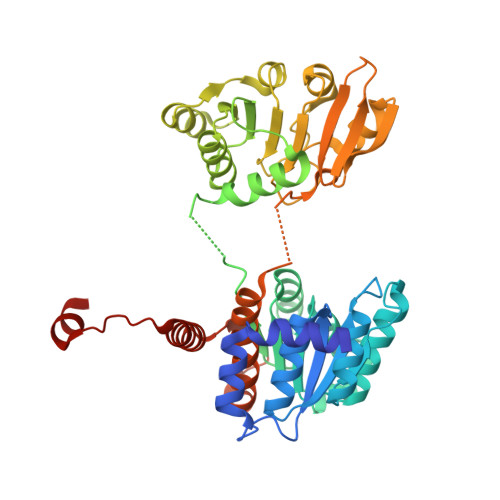S-adenosyl-L-homocysteine hydrolase from a hyperthermophile (Thermotoga maritima) is expressed in Escherichia coli in inactive form - Biochemical and structural studies.
Brzezinski, K., Czyrko, J., Sliwiak, J., Nalewajko-Sieliwoniuk, E., Jaskolski, M., Nocek, B., Dauter, Z.(2017) Int J Biol Macromol 104: 584-596
- PubMed: 28629859
- DOI: https://doi.org/10.1016/j.ijbiomac.2017.06.065
- Primary Citation of Related Structures:
5TOV, 5TOW - PubMed Abstract:
Thermotoga maritima is a hyperthermophilic bacterium but its genome encodes a number of archaeal proteins including S-adenosyl-L-homocysteine hydrolase (SAHase), which regulates cellular methylation reactions. The question of proper folding and activity of proteins of extremophilic origin is an intriguing problem. When expressed in E.coli and purified (as a homotetramer) at room temperature, the hyperthermophilic SAHase from T.maritima was inactive. ITC study indicated that the protein undergoes heat-induced conformational changes, and enzymatic activity assays demonstrated that these changes are required to attain enzymatic activity. To explain the mechanism of thermal activation, two crystal structures of the inactive form of T. maritima SAHase (iTmSAHase) were determined for an incomplete binary complex with the reduced cofactor (NADH), and in a mixture of binary complexes with NADH and with adenosine. In contrast to active SAHases, in iTmSAHase only two of the four subunits contain a bound cofactor, predominantly in its non-reactive, reduced state. Moreover, the closed-like conformation of the cofactor-containing subunits precludes substrate delivery to the active site. The two other subunits cannot be involved in the enzymatic reaction either; although they have an open-like conformation, they do not contain the cofactor, whose binding site may be occupied by an adenosine molecule. The results suggest that this enzyme, when expressed in mesophilic cells, is arrested in the activity-incompatible conformation revealed by its crystal structures.
Organizational Affiliation:
Institute of Chemistry, University of Bialystok, Ciolkowskiego 1K, 15-245 Bialystok, Poland. Electronic address: k.brzezinski@uwb.edu.pl.


















